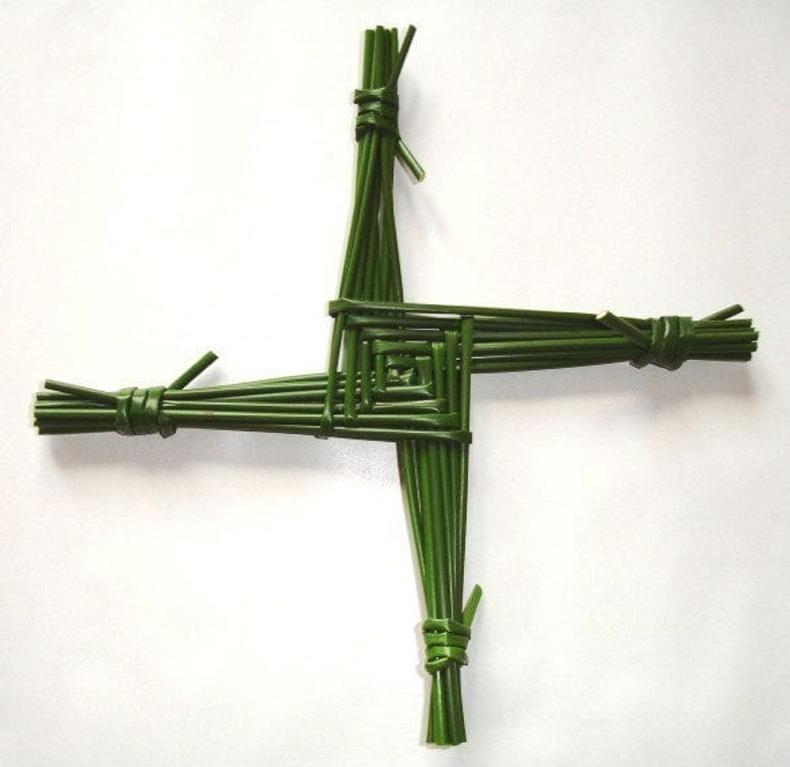I was introduced to a word I had never heard before this week. Imbolc. Do you know it?
It is a name for an ancient Gaelic festival that is celebrated still by Irish, Scottish and Manx people, as well as Celtic Neopaganism and Wiccans, a modern pagan religion. While the latter two groups observe it as a religious holiday, it is largely now celebrated as a cultural event.
Imbolc was an important pagan celebration in ancient times, but it changed in Christian times and became Lá Fhéile Bríde or St Brigid’s Day. One of four Gaelic season festivals, Imbolc is possibly the lesser known. The others are Bealtaine, Lughnasadh and Samhain.

St Brigid's Cross.
The significance of Imbolc is that is marks the midway point between the winter solstice and the spring equinox. The festival is thought to be linked to St Brigid as she was seen as a goddess of fertility. On the eve of Imbolc it was said that Brigid visited the homes of the virtuous and blessed them.
In a tradition that continues today with St Nicholas (Santa to you and me) food and drink would be set aside for Brigid on her journey, while families would gather on Imbolc Eve to have supper. In addition to providing Brigid with food and drink, families would also leave items of clothing to be blessed, and they were said to have powers to heal and protect the wearers.
A bed of rushes was also made for Brigid to rest, should she need to do so, and this developed into doll-like figures being made from the same material.
While different places had different customs, in Ireland a three- or four-armed cross would be made from rushes and hung over doors or windows. As well as welcoming Brigid, they were believed to protect the inhabitants from fire, illness and evil spirits.
For the past two weeks the Belltable Arts Centre in Limerick has been celebrating Imbolc and this week sees their third and final online production in the series. It will be live until 26 February and can be heard at limetreetheatre.ie
Introduction to Celtic Literature 101 (With a Hangover) is written by Myles Breen, directed by Simon Thompson, read by Brian Roche and with all-important sound engineering by Mark Bergin. While these stories will be free to listen to, you can do your bit to help the struggling art sector by giving them a donation online.
The two previous productions are available to listen to (visit https://bit.ly/3tWA23E) and Belltable has done well to bring together favourite Limerick artists to direct and read the stories.
These are three new adaptations of Irish stories, inspired by the time of the Tuatha de Dannan and long before the Celts ever came to Ireland. These stories of Étaín, Emer and The Ulaid are also written by Limerick artists.
Myles Breen is an actor, director and playwright, and someone who has made a huge contribution to the arts in the mid-west region. He has been performing, directing and writing for over 30 years. Roles he has performed on stage include Manus in Translations, Eugene in Biloxi Blues, Danny Mann in The Colleen Bawn, Claudius in Hamlet and various roles in Pig Town and Under Milk Wood.
Film and television credits include Fair City, Mattie, Killinaskully, Northanger Abbey, Camera Cafe, Why the Irish Dance that Way, Corp & Anam and Clash of the Ash.
Read more
Front Row: the feast of St Brigid
The Front Row: an Irish talent
I was introduced to a word I had never heard before this week. Imbolc. Do you know it?
It is a name for an ancient Gaelic festival that is celebrated still by Irish, Scottish and Manx people, as well as Celtic Neopaganism and Wiccans, a modern pagan religion. While the latter two groups observe it as a religious holiday, it is largely now celebrated as a cultural event.
Imbolc was an important pagan celebration in ancient times, but it changed in Christian times and became Lá Fhéile Bríde or St Brigid’s Day. One of four Gaelic season festivals, Imbolc is possibly the lesser known. The others are Bealtaine, Lughnasadh and Samhain.

St Brigid's Cross.
The significance of Imbolc is that is marks the midway point between the winter solstice and the spring equinox. The festival is thought to be linked to St Brigid as she was seen as a goddess of fertility. On the eve of Imbolc it was said that Brigid visited the homes of the virtuous and blessed them.
In a tradition that continues today with St Nicholas (Santa to you and me) food and drink would be set aside for Brigid on her journey, while families would gather on Imbolc Eve to have supper. In addition to providing Brigid with food and drink, families would also leave items of clothing to be blessed, and they were said to have powers to heal and protect the wearers.
A bed of rushes was also made for Brigid to rest, should she need to do so, and this developed into doll-like figures being made from the same material.
While different places had different customs, in Ireland a three- or four-armed cross would be made from rushes and hung over doors or windows. As well as welcoming Brigid, they were believed to protect the inhabitants from fire, illness and evil spirits.
For the past two weeks the Belltable Arts Centre in Limerick has been celebrating Imbolc and this week sees their third and final online production in the series. It will be live until 26 February and can be heard at limetreetheatre.ie
Introduction to Celtic Literature 101 (With a Hangover) is written by Myles Breen, directed by Simon Thompson, read by Brian Roche and with all-important sound engineering by Mark Bergin. While these stories will be free to listen to, you can do your bit to help the struggling art sector by giving them a donation online.
The two previous productions are available to listen to (visit https://bit.ly/3tWA23E) and Belltable has done well to bring together favourite Limerick artists to direct and read the stories.
These are three new adaptations of Irish stories, inspired by the time of the Tuatha de Dannan and long before the Celts ever came to Ireland. These stories of Étaín, Emer and The Ulaid are also written by Limerick artists.
Myles Breen is an actor, director and playwright, and someone who has made a huge contribution to the arts in the mid-west region. He has been performing, directing and writing for over 30 years. Roles he has performed on stage include Manus in Translations, Eugene in Biloxi Blues, Danny Mann in The Colleen Bawn, Claudius in Hamlet and various roles in Pig Town and Under Milk Wood.
Film and television credits include Fair City, Mattie, Killinaskully, Northanger Abbey, Camera Cafe, Why the Irish Dance that Way, Corp & Anam and Clash of the Ash.
Read more
Front Row: the feast of St Brigid
The Front Row: an Irish talent







 This is a subscriber-only article
This is a subscriber-only article










SHARING OPTIONS: